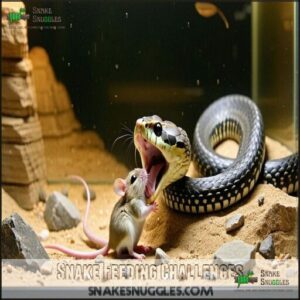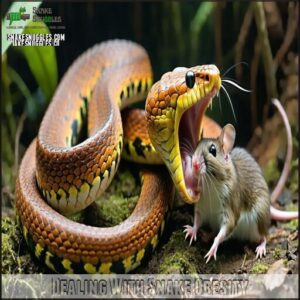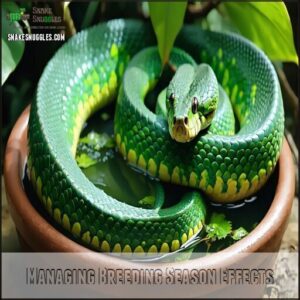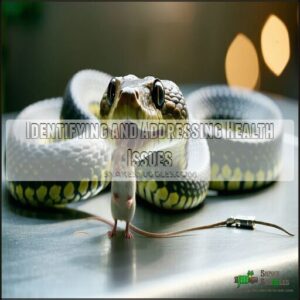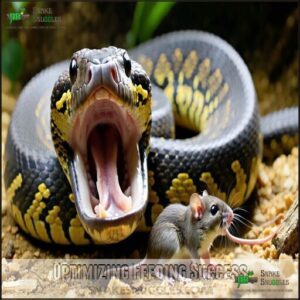This site is supported by our readers. We may earn a commission, at no cost to you, if you purchase through links.
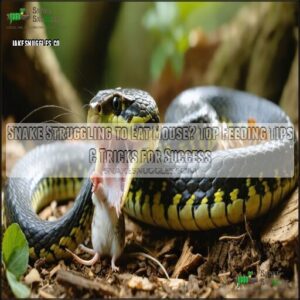
A mouse that’s too large can intimidate your snake, while one that’s too cold might not catch its interest. Thaw frozen mice thoroughly and warm them slightly—most snakes respond to the scent and heat.
Use feeding tongs to mimic natural movement and align the prey with the snake’s head.
Stress, poor health, or improper enclosure conditions can also play a role. Check for signs of illness or discomfort, and adjust the environment as needed. Sometimes, patience is the key.
Table Of Contents
- Key Takeaways
- Snake Feeding Challenges
- Identifying Hunger Cues
- Prey Presentation Techniques
- Addressing Feeding Issues
- Optimizing Feeding Success
- Frequently Asked Questions (FAQs)
- What to do if a snake is struggling to eat?
- What to do with a mouse your snake won’t eat?
- How long should it take for a snake to swallow a mouse?
- How do you tell if a snake is stressed?
- What to do if your snake won’t eat a mouse?
- Why is my snake struggling to eat?
- Why won’t my snake eat my mouse?
- How long should it take a snake to eat a mouse?
- How do I know if a mouse is too big for my snake?
- How do environmental changes affect snake eating habits?
- Conclusion
Key Takeaways
- Warm the mouse slightly and use feeding tongs to mimic natural movement, helping your snake recognize it as prey.
- Ensure the prey’s size matches your snake’s widest part; oversized prey can cause stress and refusal to eat.
- Check the enclosure’s temperature, humidity, and hiding spaces to maintain a stress-free environment.
- Look for hunger cues like tongue flicking or increased activity, and adjust the feeding approach accordingly.
Snake Feeding Challenges
When your snake struggles to eat a mouse, it’s often due to issues like sideways swallowing or improper prey alignment.
Understanding these challenges helps you address them effectively and guarantee your snake can feed without complications, which is crucial for its health and well-being.
Sideways Feeding Behavior
Sideways swallowing in snakes, like BCI and BRB angles, is common, though it can lead to struggles.
Sideways swallowing in snakes is a quirky yet common behavior, showcasing their persistence despite potential feeding struggles.
Royal Pythons often attempt sideways feeding, amusing owners yet causing frustration when prey isn’t aligned.
This behavior, while normal, highlights their persistence. Supporting proper alignment or warming prey may help.
Observing feeding behavior guarantees your snake thrives, even with occasional sideways challenges.
Prey Size and Alignment
Choosing the ideal size prey is vital for proper alignment during snake feeding.
Wide prey often causes swallowing difficulty, especially if alignment is off.
To reduce struggles like sideways swallowing, make certain prey isn’t too large for your snake’s mouth.
Techniques like head warming can encourage alignment and help.
Adjusting prey size and ensuring proper prey positioning improve feeding success.
It’s also important to evaluate frozen versus live prey options for safety and consider the benefits of proper alignment during snake feeding, which can be achieved with the right prey size.
Species-Specific Feeding Habits
Snakes have unique feeding quirks depending on their species.
Royal pythons might bite themselves when adjusting prey. BCIs and boas often use their bodies as rests. Hognose snakes seem to prefer prey sideways, while diet specialization means some snakes need specific foods.
Understanding snake food preferences and prey size guarantees a smoother feeding experience adapted to your snake’s natural habits.
Feeding Difficulties and Distress
A struggling snake facing swallowing challenges may take time to succeed.
If prey gets stuck or the snake shows pain signs, observe closely.
Abandoned prey often signals distress or misalignment.
Address snake feeding difficulties by ensuring proper prey size and preparation.
Significant feeding challenges may require intervention.
Monitor behavior calmly to avoid stress and gauge intervention needs when your snake is eating a mouse.
Identifying Hunger Cues
Understanding your snake’s body language can help you spot signs of hunger before mealtime. Look for behaviors like increased activity, frequent tongue flicking, or persistent focus on their surroundings.
Recognizing Signs of Hunger
A snake’s hunger can be spotted through its activity and behavior.
Spot hunger cues through increased activity, tongue flicking, or striking posture—your snake’s way of saying it’s ready to feed.
Look for these signs:
- Increased Activity Levels: They may explore their enclosure more than usual.
- Frequent Tongue Flicking: This shows active hunting behavior.
- Strike Posture: Your snake might coil or prepare to strike.
- Reduced Hiding: Hungry snakes often leave hides more frequently.
Observe closely for these cues.
Differentiating Between Hunger and Disinterest
A snake’s feeding frequency and behaviors reveal hunger signals or disinterest.
An enthusiastic snake may track movement or strike at prey, showing appetite vs. satiety instincts.
If your snake isn’t eating, consider behavioral changes or environmental impact—the heat, humidity, or low activity levels might signal disinterest.
Observing snake feeding behavior helps fine-tune its diet and guarantee proper health.
Observing Snake Body Language
Understanding your snake’s body language helps decode its hunger signals. A focused striking posture or slow tongue flicking often shows interest in prey.
Watch for coiling behavior around the mouse, signaling readiness to eat. Relaxed breathing patterns suggest comfort, whereas jaw alignment adjustments might reflect predation preparation.
- Striking posture shows prey focus.
- Coiling behavior signals readiness.
- Adjusting jaw alignment aids swallowing.
- Breathing patterns reveal comfort level.
Observing these cues clarifies intentions, minimizing feeding challenges and improving snake feeding behavior.
Monitoring Feeding Behavior
Keep a close eye on your snake’s feeding habits to understand its needs.
Frequency observation helps spot patterns, while behavior documentation reveals issues like struggling with prey.
Progress tracking guarantees the snake’s diet aligns with its health.
Combine weight monitoring with health assessment to pinpoint concerns.
These snake feeding tips guarantee your pet thrives, even when eating a mouse is challenging, and help with progress tracking.
Prey Presentation Techniques
How you present prey can make all the difference when your snake struggles to eat. From warming the mouse to adjusting its position, small techniques can improve feeding success.
Tong Presentation Methods
Using feeding tongs effectively can improve snake feeding success.
Adjust the tong angle for better prey placement, ensuring your grip strength is firm but gentle.
A slow, natural movement style mimics live prey, stimulating strike responses.
Position the prey in front of your snake’s head, avoiding sudden movements.
Mastering prey presentation is a key snake care skill, enhancing feeding tips and techniques.
Using tongs also helps minimize the risk of accidental handler bites.
Heating Prey for Stimulation
Warm prey correctly to boost feeding success. Snakes are drawn to heat, mimicking live prey.
Try these warming methods:
- Heat prey’s head to ideal temperature with a hair dryer.
- Soak prey’s head in warm water for enhanced scent and stimulation.
- Let prey thaw fully at room temperature first.
Consider using snake heat lamps to maintain ambient temperatures.
- Make certain head warmth encourages a stimulating strike response to achieve the best results with warm prey.
Using Scenting Techniques
Heating the prey helps, but sometimes snakes need an extra push.
Scenting prey is an effective trick. Rub a natural scent source, like lizards or frogs, onto the mouse. This method stimulates the brain while increasing prey acceptance.
Experiment with options to find a scent that works. You can even purchase reptile scent attractants for enhanced results.
Snake feeding scenting requires patience, but it’s a game-changer in snake feeding techniques.
Combining Prey Items
Combining multiple prey items can solve feeding challenges and improve nutritional balance.
Try these snake feeding tricks:
- Use scent layering by rubbing one prey on another.
- Offer smaller items together for prey variety.
- Switch foods by tying prey items.
- Present mixed prey to stimulate feeding.
- Rotate prey types to ease snake feeding solutions.
These snake feeding methods encourage success during feeding struggles and can help by using techniques like scent layering.
Addressing Feeding Issues
When your snake struggles to eat, checking for potential stressors, health issues, or environmental problems is essential.
Addressing these factors quickly can help improve feeding success and guarantee your snake stays healthy.
Dealing With Snake Obesity
Tackling snake obesity starts with monitoring weight and evaluating the snake diet.
Adjust meal sizes and feeding intervals to match activity levels, and verify prey fits their body diameter.
Add exercise options like climbing structures to burn calories.
The snake diet involves drastic calorie cuts.
Obesity prevention is key to reducing serious health risks like organ damage.
Regularly track your snake’s health for long-term success.
Managing Breeding Season Effects
During breeding season, snakes may eat less due to hormonal appetite changes or breeding stress.
Gravid behavior, where females retain eggs, can also reduce feeding.
Shedding impacts their comfort and willingness to eat.
Keep an eye on your snake’s behavior to adjust care as needed.
- Monitor for reduced feeding patterns.
- Provide a stress-free environment.
- Make certain access to fresh water.
- Maintain consistent temperatures.
- Offer smaller prey options to support their nutritional needs during this critical period, ensuring they have access to fresh water and are in a comfortable environment with consistent temperatures.
Identifying and Addressing Health Issues
Health issues can make feeding tough.
Watch for signs like respiratory problems or oral discomfort.
A sluggish snake might’ve a vitamin deficiency or digestive issues.
Probiotic support and appetite stimulants can help, but consult a veterinarian for guidance.
| Issue | Symptom | Solution |
|---|---|---|
| Respiratory Problems | Mouth gaping | Adjust environment, vet check |
| Oral Discomfort | Refusal to eat | Check mouth, treat infection |
| Vitamin Deficiency | Low energy levels | Add supplements or probiotics |
The table provides a summary of common issues, their symptoms, and potential solutions.
It is essential to identify the root cause of the problem to provide the appropriate treatment.
Environmental Factors and Stress
Maintaining proper enclosure temperature and humidity levels is vital for your snake’s health.
Provide hiding spots to help reduce stress, and check your lighting schedule for consistency.
Stress can heavily impact feeding, so monitor the environment carefully.
A stable enclosure with proper humidity, temperature, and lighting creates a secure space, encouraging relaxed feeding behavior and overall well-being.
Optimizing Feeding Success
You can improve your snake’s feeding success by focusing on the right prey size, type, and presentation.
Maintaining proper environmental conditions also guarantees your snake stays comfortable and ready to eat.
Selecting Correct Mouse Size
Choosing the right mouse size is essential for smooth snake feeding and digestion ease.
Prey weight, snake age, and species variation matter. A prey item too big may cause regurgitation, while one too small doesn’t satisfy.
- Match prey width to your snake’s widest part.
- For young snakes, use smaller rodents.
- Gradually adjust as the snake grows.
Hatchlings, for example, often require hopper mice initially.
Experimenting With Mouse Types
If your snake struggles with mice, experimenting with variety can help.
Scented mice might trigger their natural instincts, while frozen vs. live options could impact feeding behavior.
Trying smaller pinkie variety or multiple prey items at once also works well.
Focus on the nutritional value of each choice to guarantee your snake gets the best from its prey items.
Gradually Introducing New Food
Switching up food variety might help your snake overcome feeding challenges.
Start small with pre-killed prey like pinkie mice, gradually increasing food size as they adapt.
A scent shift, such as rubbing prey with reptile-safe supplements, can spark interest.
For picky eaters, tying prey items together creates familiarity during the snake feeding shift.
Patience guarantees smoother feeding success.
Maintaining Optimal Environment Conditions
If new foods aren’t working, check the setup.
Proper temperature gradients and humidity levels in the enclosure matter.
Use hiding spots and a consistent lighting schedule to reduce stress.
Verify the enclosure size suits the snake’s needs.
Small environmental adjustments in snake husbandry can improve feeding success.
Balanced humidity and warmth create comfort, directly aiding snake feeding.
Ideal feeding can be achieved with proper enclosure products, which is crucial for snake feeding and overall enclosure success.
Frequently Asked Questions (FAQs)
What to do if a snake is struggling to eat?
If your snake struggles to eat, offer smaller prey, make certain it’s aligned headfirst, and warm it slightly.
Check enclosure conditions (humidity, temperature) and minimize stress.
Use feeding tongs, and only assist if entirely necessary.
What to do with a mouse your snake won’t eat?
When dinner plans go sideways, freeze the uneaten mouse promptly to avoid waste.
Store it properly, and try offering it later.
Adjust prey preparation or feeding conditions to better match your snake’s preferences next time.
How long should it take for a snake to swallow a mouse?
It typically takes a snake 15 to 60 minutes to fully swallow a mouse, depending on its size, alignment, and the snake’s experience.
If it struggles substantially longer, you might need to intervene or reassess conditions.
How do you tell if a snake is stressed?
You might think snakes always appear calm, but stress signals include excessive hiding, rapid breathing, refusing food, or unusual aggression.
Check for changes in behavior, poor environment setup, or health issues causing the stress.
What to do if your snake won’t eat a mouse?
If your snake won’t eat a mouse, check its enclosure’s temperature and humidity, make certain the prey is warmed, and try offering smaller or scented prey.
Reduce stress by providing hiding spots and observing its behavior closely, which can help identify the issue with your snake not eating, potentially related to stress.
Why is my snake struggling to eat?
Alignment, stress, or prey size can trip things up.
Your snake may struggle with awkward positioning, environmental stress, or an oversized mouse.
Make certain prey fits, adjust enclosure conditions, and monitor for distress or health concerns, ensuring the snake’s well-being and environmental stability.
Why won’t my snake eat my mouse?
Your snake could be stressed, the mouse might be too big, or your setup might need adjustment.
Check the enclosure’s temperature and humidity, try warming the mouse’s head, or consider offering smaller prey.
How long should it take a snake to eat a mouse?
It usually takes a snake 10 to 60 minutes to eat a mouse, depending on prey size and alignment.
If it struggles longer, check for improper positioning, stress, or environmental issues affecting its feeding behavior.
How do I know if a mouse is too big for my snake?
A mouse is too big if it’s wider than your snake’s widest body part.
Offer prey roughly 5 times your snake’s head width.
Oversized prey risks choking, injuries, or your snake refusing to eat altogether.
How do environmental changes affect snake eating habits?
Think of your snake like a thermostat-sensitive diner.
Small shifts in temperature or humidity can throw off appetite.
If it’s too cold, they’ll conserve energy; too dry, and swallowing gets tough.
Balance is everything for feeding success, as small changes can significantly impact your snake’s behavior and appetite, making feeding a delicate process.
Conclusion
Remember, patience is a virtue when your snake’s struggling to eat a mouse.
Focus on proper prey size, alignment, and temperature to encourage feeding. Warm the prey slightly to mimic a live animal, and use feeding tongs for lifelike movement.
Check your snake’s health, environment, and stress levels to verify favorable conditions. Hunger cues and body language can guide your efforts.
With consistent care and the right techniques, your snake is more likely to eat successfully.
- https://www.justanswer.com/pet-reptile/ovp4j-snake-won-t-eat-bought-mice-likes.html
- https://community.morphmarket.com/t/when-and-when-not-to-assist-feed/29702
- https://www.quora.com/What-should-I-do-if-my-snake-is-afraid-of-the-mouse-I-bought-as-its-food
- https://pets.stackexchange.com/questions/23823/my-yellow-rat-snake-was-eaten-by-a-live-pet-mouse
- https://medium.com/@morelialife33/what-to-do-if-your-snake-wont-eat-63beedc92e88

